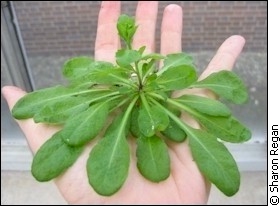 |
| Sharon Regan is using the wonder weed Arabidopsis to unwind the genetic secrets of the poplar. |
Like a true tree fanatic, Sharon Regan sits tucked in behind an office desk littered with dozens of photos of trees.
"I want to know how trees make wood," explains the plant biotechnologist at Carleton University.
To put it simply, she's in search of a few good trees. "Every tree out there is different," explains Regan, "you want to identify the ones that are the best."
She's concentrating her efforts on the poplar, which, along with spruce, provides the wood
fibres needed for paper production. She thinks at least some of the answers can be
found through genetic research.
So there's the task. How do you go about finding the needle in the haystack, or the single tree in the forest?
Every good sleuth knows to leave no stone unturned, and Regan looks in what would at first seem like the most unlikely of places.
Her hunch is that some of the basic answers can be found by studying the genome of a tiny weed known as Arabidopsis thaliana. Commonly known as mouse-ear cress thanks to the shape of its leaves, the plant, along with broccoli and cauliflower, belongs to the mustard family.
"Arabidopsis is the most well-studied plant in the world," explains Regan. "It's really easy to study because it has a small amount of DNA. As a result of the efforts of probably 1,000 labs around the world the sequence of the entire genome has been finished."
Just across the hall from her office at Carleton University where she runs the plant biotechnology lab, Regan keeps a greenhouse with hundreds of Arabidopsis specimens. She insists that despite their size, their genomic information is quite pertinent to study larger and more complex plants — such as the poplar.
"Even though it's a small weed, I can still ask basic questions about wood formation in Arabidopsis," says Regan, pointing to the plants in the greenhouse. "Poplar has much more DNA but the gene structure appears to be very similar."

|

